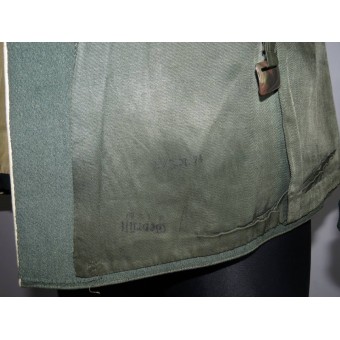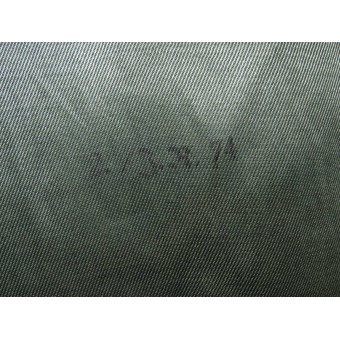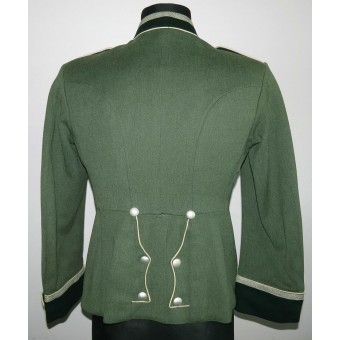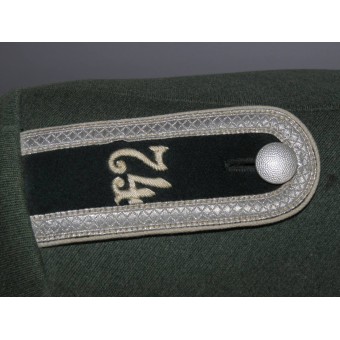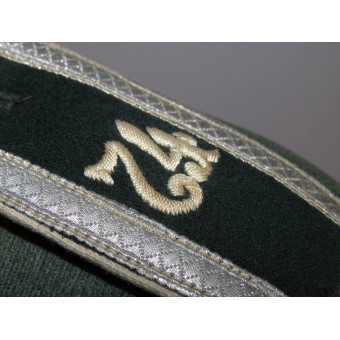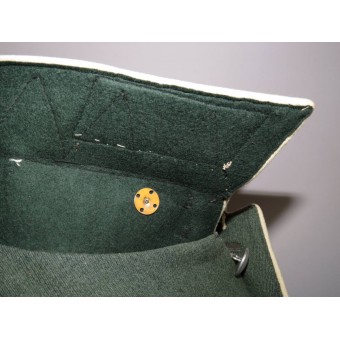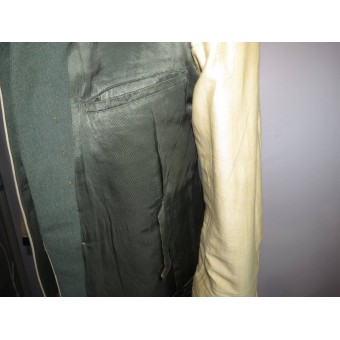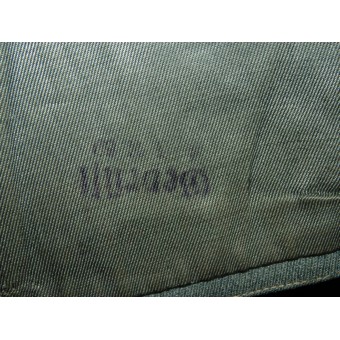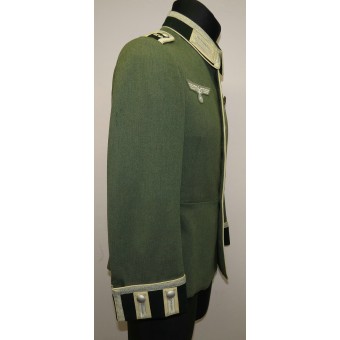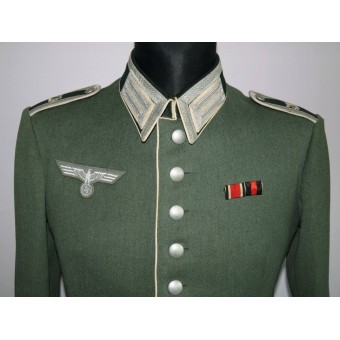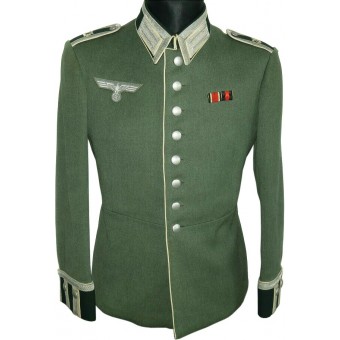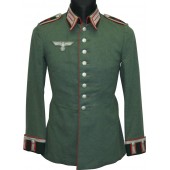Wehrmacht Heer Waffenrock Unteroffizier Infantry Schuetzen Regiment 74
Wehrmacht Heer Waffenrock for rank of Unteroffizier of Infantry in Schützen Regiment 74. The tunic is marked Geprüft by previous unit of the owner J.R.59, and then added markings of 2. J.R. 74. The tunic is perfectly tailored from gabardine tricot and is in very good condition, the woven flatwire eagle is an early example, made after the Reichswehr. The both 59 and 74 Regiments were a part of 19th Panzer Division. The divison has long battle history in Europe and Ostfront. For more information about this unit please check the History tab.
The 19th Panzer Division was established on 1 November 1940 at the military district XI. It was created by the reclassification of the 19th Infantry Division. The Infantry Regiment 59 profited from the newly formed 20th Panzer Division, which strung elements of the division to the 131st Infantry Division. From 20 June 1941, the Division took part in the Central Army Group on the Russian campaign as part of Panzer Group. 3 As a division of the 2nd wave marched the division over the Niemen to the east and then swung south towards Minsk from. In D. Zemloslaw it came the end of June 1941 the first heavy defensive battles under the boiler Battle of Bialystok and Minsk. Following the division marched through Minsk to Dzisna on the Dvina, which was taken on July 4. On July 5, the Division crossed the Dvina and then broke through the Stalin Line. Then the Division marched towards Polotsk and broke the Dryssa position. Before Polotsk the Division turned from 17 July to the north, reaching Velikiye-Luki. Here remained the division by 20 July. On this day the Division conceded again the city and marched Welish. Then she waved to the north, then later to the east over the Daugava to Ilino. This was followed by the rise on both sides of the street Smolensk - Bjeloy up in the room Potschenki. After heavy fighting in this area the Division in early August 1941, withdrawn from the front and freshened frontnah at Schischkowo. On August 18, the division was ordered to advance again to Velikiye Luki and there enclose suspected enemy forces. It came to the second Battle of Velikiye-Luki. Even before the final end to the fighting marched the Division continue towards Toropjez, then toward Chelm and then towards Demjansk. After passage through the Demjansk Division closed the rear edge of the boiler formed to Staraya Russa. Even before the final clearing of the boiler, the division was withdrawn and transferred to the area of 123th Infantry Division at Ostashkov. This was in the room Sslautino. The use here lasted only a few days and from 12 October 1941, the Division in the attack on Moscow part. At the onset of the Russian counter-offensive before Moscow, the division in the room was Juchnow - Sukhinichi pushed back. The Division formed to Juchnow a ring and there was severe defensive fighting. From the end of January 1942, the division fought in space Jekaterinowka in heavy defensive battles. The incipient thaw in late May 1942 resulted in a flattening of the Russian attacks. In mid-May 1942 was followed by the company "Hannover", a limited offensive Corporate north taxiway between Suiza and Desna south Yelnya. Anfanj July 1942 then moved the Division in the area Bryansk to be used here against a Russian offensive from the Kirov bow. In Dimitriewka there was severe defensive fighting. On August 11, 1942, the German counterattack on the Shisdra began, but did not hit, and finally lay on the Shisdra. In October 1942, the Division has been transferred from the Shisdra-section and moved into the room in the Orel Orelbogen. Contrary to the planning, to allow draw their winter quarters Division here moved this early November to Bryansk, where it was two weeks freshened frontnah. Subsequently, the Division had to move on a forced march to Smolensk. South of Bjeloy there were heavy defensive fighting erupted Russian units that could be rounded up in the course of these struggles. In mid-January 1943 before ending the fighting in this area, the Division was withdrawn from the front and speeds transferred to the Stalingrad area. The Division was established upon their arrival in the area north of Stalingrad in the space of 8 Italian army. A first position was based in space Strelzowka. Then the division on the Donets withdrew and built here a new resistance line on. Then could find some rest in the rear space division. In July 1943, the Division took part of the III. Panzer Corps in the company "Citadel", the offensive at Kursk, in part. After the start of the Russian counteroffensive Division threatened the encirclement. On the night of August 10, she was able to escape from the encirclement and it was used in space Akhtyrka for defense. By mid-September 1943, the defense and retreat fighting continued north of Akhtyrka. Finally, the division of the Dnieper had to withdraw. In Kiev, the Division crossed the river and then marched south into the Dnieper knee. At the turn of 1943/44 the Division was withdrawn from the front and west moved into the space of Kiev, to engage the Christmas-offensive at Brussiloff. In lossy retreat, the Division had had to retreat into the room Zhitomir. Subsequently, the Division in the area Shepetovka was used and came in March 1944 with the 1st Panzer Army in the boiler of Kamenetz-Podolsk. In June 1944, the Division moved to refresh to Denmark. After the start of the Russian summer offensive against Army Group Center and the collapse of the German front have not yet again completely refreshed Division in mid-July 1944, shipped and laid on the training area Arys in East Prussia. From here they marched into the room Grodno-Bialystok. This was followed by the use of the Russian Warka bridgehead south of Warsaw. Having failed to depress the bridgehead, the division was in the battles for Warsaw involved (Warsaw Uprising). After the suppression of the uprising, the fighting subsided in this area. On 11 January 1945 the Russian winter offensive, which had to set against the 19th Panzer Division began nothing. At the Warta was trying to build with the remnants of the Division and the armored corps "Greater Germany" a resistance line. Subsequently, the division in the Lausitz should be refreshed. The remainder of the division but were used immediately against Russian Oder bridgehead at Steinau. Subsequently, the Division remains laid to Wroclaw to prevent the encirclement of the city. After the final enclosure of the city, the division had to withdraw through central Silesia, until it reached the Moravian Gate in late March 1945th In mid-April 1945, the Division for Moravska Ostrava and Brno in the room. When the war ended, the last remnants of the Division fought in the Protectorate Bohemia and Moravia.
The book to read: Adalbert Wasner: Infanterie- und Panzergrenadier-Regiment 74. Erinnerungen an den Weg des Regiments durch Polen, Holland, Belgien, Frankreich und Rußland 1939 - 1945, Hrsg. Kameradschaft 74, Hannover 1970
http://www.lexikon-der-wehrmacht.de/Gliederungen/Panzerdivisionen/19PD-R.htm
Wehrmacht Heer Waffenrock for rank of Unteroffizier of Infantry in Schützen Regiment 74. The tunic is marked Geprüft by previous unit of the owner J.R.59, and then added markings of 2. J.R. 74. The tunic is perfectly tailored from gabardine tricot and is in very good condition, the woven flatwire eagle is an early example, made after the Reichswehr. The both 59 and 74 Regiments were a part of 19th Panzer Division. The divison has long battle history in Europe and Ostfront. For more information about this unit please check the History tab.
The 19th Panzer Division was established on 1 November 1940 at the military district XI. It was created by the reclassification of the 19th Infantry Division. The Infantry Regiment 59 profited from the newly formed 20th Panzer Division, which strung elements of the division to the 131st Infantry Division. From 20 June 1941, the Division took part in the Central Army Group on the Russian campaign as part of Panzer Group. 3 As a division of the 2nd wave marched the division over the Niemen to the east and then swung south towards Minsk from. In D. Zemloslaw it came the end of June 1941 the first heavy defensive battles under the boiler Battle of Bialystok and Minsk. Following the division marched through Minsk to Dzisna on the Dvina, which was taken on July 4. On July 5, the Division crossed the Dvina and then broke through the Stalin Line. Then the Division marched towards Polotsk and broke the Dryssa position. Before Polotsk the Division turned from 17 July to the north, reaching Velikiye-Luki. Here remained the division by 20 July. On this day the Division conceded again the city and marched Welish. Then she waved to the north, then later to the east over the Daugava to Ilino. This was followed by the rise on both sides of the street Smolensk - Bjeloy up in the room Potschenki. After heavy fighting in this area the Division in early August 1941, withdrawn from the front and freshened frontnah at Schischkowo. On August 18, the division was ordered to advance again to Velikiye Luki and there enclose suspected enemy forces. It came to the second Battle of Velikiye-Luki. Even before the final end to the fighting marched the Division continue towards Toropjez, then toward Chelm and then towards Demjansk. After passage through the Demjansk Division closed the rear edge of the boiler formed to Staraya Russa. Even before the final clearing of the boiler, the division was withdrawn and transferred to the area of 123th Infantry Division at Ostashkov. This was in the room Sslautino. The use here lasted only a few days and from 12 October 1941, the Division in the attack on Moscow part. At the onset of the Russian counter-offensive before Moscow, the division in the room was Juchnow - Sukhinichi pushed back. The Division formed to Juchnow a ring and there was severe defensive fighting. From the end of January 1942, the division fought in space Jekaterinowka in heavy defensive battles. The incipient thaw in late May 1942 resulted in a flattening of the Russian attacks. In mid-May 1942 was followed by the company "Hannover", a limited offensive Corporate north taxiway between Suiza and Desna south Yelnya. Anfanj July 1942 then moved the Division in the area Bryansk to be used here against a Russian offensive from the Kirov bow. In Dimitriewka there was severe defensive fighting. On August 11, 1942, the German counterattack on the Shisdra began, but did not hit, and finally lay on the Shisdra. In October 1942, the Division has been transferred from the Shisdra-section and moved into the room in the Orel Orelbogen. Contrary to the planning, to allow draw their winter quarters Division here moved this early November to Bryansk, where it was two weeks freshened frontnah. Subsequently, the Division had to move on a forced march to Smolensk. South of Bjeloy there were heavy defensive fighting erupted Russian units that could be rounded up in the course of these struggles. In mid-January 1943 before ending the fighting in this area, the Division was withdrawn from the front and speeds transferred to the Stalingrad area. The Division was established upon their arrival in the area north of Stalingrad in the space of 8 Italian army. A first position was based in space Strelzowka. Then the division on the Donets withdrew and built here a new resistance line on. Then could find some rest in the rear space division. In July 1943, the Division took part of the III. Panzer Corps in the company "Citadel", the offensive at Kursk, in part. After the start of the Russian counteroffensive Division threatened the encirclement. On the night of August 10, she was able to escape from the encirclement and it was used in space Akhtyrka for defense. By mid-September 1943, the defense and retreat fighting continued north of Akhtyrka. Finally, the division of the Dnieper had to withdraw. In Kiev, the Division crossed the river and then marched south into the Dnieper knee. At the turn of 1943/44 the Division was withdrawn from the front and west moved into the space of Kiev, to engage the Christmas-offensive at Brussiloff. In lossy retreat, the Division had had to retreat into the room Zhitomir. Subsequently, the Division in the area Shepetovka was used and came in March 1944 with the 1st Panzer Army in the boiler of Kamenetz-Podolsk. In June 1944, the Division moved to refresh to Denmark. After the start of the Russian summer offensive against Army Group Center and the collapse of the German front have not yet again completely refreshed Division in mid-July 1944, shipped and laid on the training area Arys in East Prussia. From here they marched into the room Grodno-Bialystok. This was followed by the use of the Russian Warka bridgehead south of Warsaw. Having failed to depress the bridgehead, the division was in the battles for Warsaw involved (Warsaw Uprising). After the suppression of the uprising, the fighting subsided in this area. On 11 January 1945 the Russian winter offensive, which had to set against the 19th Panzer Division began nothing. At the Warta was trying to build with the remnants of the Division and the armored corps "Greater Germany" a resistance line. Subsequently, the division in the Lausitz should be refreshed. The remainder of the division but were used immediately against Russian Oder bridgehead at Steinau. Subsequently, the Division remains laid to Wroclaw to prevent the encirclement of the city. After the final enclosure of the city, the division had to withdraw through central Silesia, until it reached the Moravian Gate in late March 1945th In mid-April 1945, the Division for Moravska Ostrava and Brno in the room. When the war ended, the last remnants of the Division fought in the Protectorate Bohemia and Moravia.
The book to read: Adalbert Wasner: Infanterie- und Panzergrenadier-Regiment 74. Erinnerungen an den Weg des Regiments durch Polen, Holland, Belgien, Frankreich und Rußland 1939 - 1945, Hrsg. Kameradschaft 74, Hannover 1970
http://www.lexikon-der-wehrmacht.de/Gliederungen/Panzerdivisionen/19PD-R.htm




